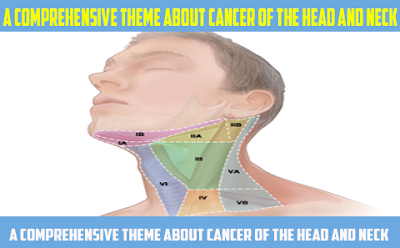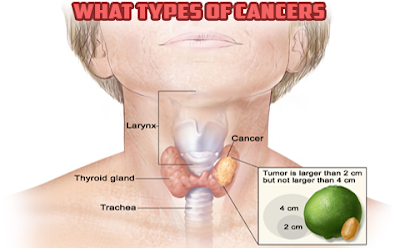A comprehensive theme about Cancer of the Head and Neck
 |
| cancer of the head and neck |
Facts about head and neck cancer
Facts about head and neck cancer by John P. Cunha, DO, FACOE
Head and neck cancers are identified by the area in which they begin: the oral cavity, salivary glands, paranasal sinuses and nasal cavity, pharynx, larynx (voice box), and lymph nodes in the neck. Cancers of the brain, eyes, thyroid gland, scalp, skin, muscles and bones of the head and neck are not usually clustered with cancers of the head and neck.
The main causes of head and neck
cancer include smoking (smoking or chewing) and alcohol. Other risk factors include exposure to sunlight, infection with human papillomavirus (HPV), head and neck radiation, Asian ancestry, Epstein-Barr virus infection, exposure to dust Wood or asbestos in air in the air, consumption of certain preservatives or salty foods, poor oral hygiene, and this syndrome (also called Paterson-Kelly).
- Common symptoms of multiple head and neck cancer sites include a noodle or sore that will not heal, a sore throat that does not go away, difficulty swallowing, and a change or explosion in your voice. Symptoms may vary depending on which part of the head or neck is cancerous.
- Tests and tests to diagnose cancer of head and neck symptoms vary and may include a biopsy, endoscopy, blood or urine tests, X-rays, CT scan, magnetic resonance imaging and PET scan.
- The treatment of head and neck cancers depends on the exact location of the tumor, the stage of cancer and the person's age and general health. Treatment options include surgery, radiation, and chemotherapy.
- Depending on the location of the cancer and the type of treatment, rehabilitation may include physical therapy, dietary counseling, speech therapy and / or learning to care for a stoma after a laryngectomy. Some patients may need reconstructive and plastic surgery.
What is cancer?
 |
| what is cancer? |
Cancer is a group of many related diseases that start in cells, the basic unit of the body of life. All tissues and organs of organs are composed of cells of different types. Normally, cells grow and divide to form new cells in an orderly fashion. They will be elected for a time, and then die. Sometimes, however, the cells do not die. Instead, they continue to divide and create new cells that the body does not need. Additional cells form a mass of tissue called growth or tumor. There are two types of tumors: benign and malignant. Benign tumors are not cancerous. They do not invite nearby tissues or extend to other parts of the body. Malignant tumors are cancer. Its growth invades the normal structures near the tumor and the spread to other parts of the body. Metastasis is the spread of cancer beyond a place in the body.
What types of cancers are considered head and neck cancers?
 |
| what types of cancers are considered head and neck cancers ? |
Most cancers of the head and neck start in the cells that line the mucosal surfaces in the head and neck, such as the mouth, nose and throat. The mucosal surfaces are moist tissues that form hollow organs and body cavities open to the environment. Normal mucosal cells appear to be flaky (scaly) under the microscope, so cancers of the head and neck are often called squamous cell carcinomas. Some types of head and neck cancer begin in other types of cells. For example, cancers that originate in cells of glands such as sputum or salivary glands are called adenocarcinomas.
Head and neck cancers are identified by the area in which they begin:
oral cavity. The oral cavity includes the lips, the front two thirds of the tongue, gums, the buccal mucosa (inner lining of the cheeks and lips), the floor (lower) of the mouth under the tongue, hard palate Bony upper part of the mouth), and the small area behind the wisdom teeth.
Salivary glands. Salivary glands produce saliva, the fluid that keeps the mucosal surfaces in the mouth and throat moist. There are many salivary glands; The largest are on the floor of the mouth and close to the jaw.
Sinuses and the nasal cavity. The paranasal sinuses are small hollow spaces in the bones of the head that surrounds the nose. The nasal cavity is the cavity in the nose.
Pharynx. The pharynx is a hollow tube approximately 5 inches long that begins behind the nose and leads to the esophagus (the tube that goes to the stomach) and the trachea (the tube that goes beyond the lungs). The pharynx has three parts:
Nasopharynx. The nasopharynx, the upper part of the pharynx, is behind the nose.
Oropharynx. The oropharynx is the middle part of the pharynx. The oropharynx includes the soft palate (the back of the mouth), the posterior third or base of the tongue and the tonsils.
The hypopharynx. The hypopharynx is the lower part of the pharynx.
Larynx. The larynx, also called the voice box, is a short passage formed by the cartilage just below the pharynx in the neck. The larynx contains the vocal cords. It also has a small piece of tissue, called the epiglottis, which moves to cover the larynx to prevent food from entering the airways.
Lymph nodes in the upper neck. Sometimes, squamous cancer cells are found in the lymph nodes of the upper neck when there is no trace of cancer in other parts of the head and neck. When this happens, the cancer is called metastatic squamous neck cancer with unknown primary tumor (hidden or hidden).
Brain, eye and thyroid cancers, as well as those of the scalp, skin, muscle, and bone of the head and neck are not usually clustered with cancers of the head and neck.
What is the frequency of head and neck cancers?
Head and neck cancers account for about 3% to 5% of all cancers in the United States. These cancers are more common in men and in people over 50 years. An estimated 39,000 men and women in this country will develop head and neck cancer in 2005.
What causes head and neck cancer?
Tobacco (including smokeless tobacco, sometimes called "chewing tobacco" or "tobacco") and alcohol consumption are the most important risk factors for head and neck cancers, especially oral cavity, oropharynx, hypopharynx And the larynx. Eighty-five percent of head and neck cancers are related to tobacco use. People who use tobacco and alcohol are more likely to develop these types of cancer than people who use either tobacco or alcohol alone.
Other risk factors for head and neck cancer include:
oral cavity. Exposure to sunlight (lip); Infection with human papillomavirus (HPV) is a cause of increased frequency of oral cavity and oropharyngeal cancers.
Salivary glands. Radiation on the head and neck. This exposure may come from diagnostic or X-ray radiation therapy for non-cancerous diseases or cancer.
Sinuses and the nasal cavity. Some industrial exposures, such as inhalation of wood or nickel. Tobacco and alcohol use may play a less important role in this type of cancer.
Nasopharynx. , Chinese ancestry in particular from Asia; Infection with the Epstein-Barr virus; Occupational exposure to wood dust; And the consumption of certain preservatives or salty foods.
Oropharynx. Poor oral hygiene; HPV infection and the use of high alcohol mouthwash are possible, but not proven, risk factors.
The hypopharynx. Plummer-Vinson syndrome (also called Paterson-Kelly), a rare disorder that results from iron and other nutritional deficiencies. This syndrome is characterized by severe anemia and leads to difficulty swallowing due to layers of tissue growing in the upper esophagus.
Larynx. Exposure to asbestos particles in the air, especially in the workplace.
Southeast Asian immigrants who use paan (betel) in their mouths should be aware that this habit is strongly associated with an increased risk of oral cancer. In addition, consumption of mate, a tea drink generally consumed by South Americans, was associated with an increased risk of cancer of the mouth, throat, esophagus and larynx.
People who are prone to having head and neck cancer should talk to their doctor about whether they can reduce their risk. They should also discuss the frequency of reviews.
What are the common symptoms of head and neck cancer?
Symptoms of several head and neck cancer sites include a noodle or pain that will not heal, a sore throat that does not go away, difficulty swallowing, and a change or explosion in your voice. Other symptoms may include the following:
oral cavity. A white or red patch on the gums, tongue or mucous membrane of the mouth; Inflammation of the jaw that makes the prosthesis fit poorly or feel uncomfortable; And unusual bleeding or pain in the mouth.
Nasal cavity and paranasal sinuses. Paranasal sinuses that are blocked and not clear, chronic sinus infections that do not respond to antibiotic treatment, nosebleeds, frequent headaches, swelling or other problems with the eyes, pain in the upper teeth or problems with dentures .
Salivary glands. Swelling under the chin or around the jaw; Numbness or paralysis of the muscles of the face; Or pain that does not go away on the face, chin or neck.
Oropharynx and hypopharynx. Ear pain.
Nasopharynx. Trouble breathing or speech, frequent headaches, ringing in your ears or hearing loss.
Larynx. Swallowing pain or ear pain.
Metastatic squamous cell cancer. Pain in the neck or throat that does not go away.
These symptoms may be caused by cancer or other less serious conditions. It is important to consult a doctor or dentist about any of these symptoms.
How are head and neck cancers diagnosed?
To find the cause of the symptoms, the physician evaluates a person's medical history, perform a physical examination, and order diagnostic tests. Tests and tests may vary depending on the symptoms. A biopsy may be recommended and performed according to the results of previous tests. A biopsou is a limited surgical procedure that replaces a small piece of tissue. Examination of a sample of tissue under a microscope is always necessary to make a diagnosis of cancer.
Some tests and tests that may be helpful are described below:
The physical examination may include visual inspection of the buccal and nasal cavities, neck, throat and tongue using a small mirror and / or lights. The doctor may also feel bumps on the neck, lips, gums and cheeks.
Endoscopy is the use of a thin, informed tube called an endoscope to examine internal areas of the body. The type of endoscope used by the doctor depends on the area being examined. For example, a laryngoscope is inserted into the mouth to see the larynx; An oesophagoscope is inserted into the mouth to examine the esophagus; And a nasopharyngoscope is inserted into the nose so the doctor can see the nasal cavity and the nasopharynx.
Laboratory tests examine blood, urine, or other substances in the body.
X-rays create images of internal head and neck areas in the film.
The computed tomography (CT) scanner is a series of detailed images of areas inside the head and neck created by a computer connected to an X-ray machine
Magnetic resonance imaging (or MRI) uses a very powerful magnet attached to a computer to create detailed images of areas inside the head and neck.
Analysis of PET uses sugar that has been modified in a specific way, so it is absorbed by cancer calls and appear as dark areas in the analysis.
If the diagnosis is cancer, the doctor will want to know the stage (or extent) of the disease. Staging is a careful attempt to determine if the cancer has spread and, if so, to what parts of the body. The staging may involve examination under anesthesia (in the operating room), X-rays and other imaging procedures and laboratory tests. Knowledge of the stage of the disease helps the medical treatment plan.
What health professionals treat patients with head and neck cancer?
Patients with head and neck cancer are best treated by a team of specialists. Experts vary depending on the location and extent of the cancer. The medical team may include oral surgeons; Ear, nose and throat (also known as ear, nose, and throat) surgeries; Pathologists; Medical oncologists; Radiation oncologists; Prosthodontists; Dentists; Plastic surgeons; Dieticians; social workers; Nurses; physiotherapists; And speech therapists (sometimes called speech therapists).
What is head and neck cancer?
The treatment plan for an individual patient depends on a number of factors, including the exact location of the tumor, the stage of the cancer and the person's age and general health. Patient and physician should carefully consider treatment options. They should discuss each treatment and how it could change the way the patient looks, talks, eats and breathes.
Surgery. The surgeon can remove the cancer and some of the healthy tissue around it. Lymph nodes in the neck can also be removed (lymph node dissection) if the doctor suspects the cancer has spread. Surgery may be followed by radiation therapy.
Head and neck surgery often changes the patient's ability to chew, swallow or talk. The patient may be different after surgery, and the face and neck may be swollen. The swelling usually goes away within a few weeks. However, dissection of lymph nodes can slow down the flow of lymph, which can accumulate in the tissues; This swelling can last a long time. After a laryngectomy (surgery to remove the larynx), parts of the neck and throat may feel numb because the nerves are cut off. If lymph nodes are removed in the neck, the shoulder and neck may be weak and stiff. Patients should report any side effects to their doctor or nurse, and discuss the approach.
Radiation therapy, also called radiotherapy. This treatment involves the use of high-energy x-rays to kill cancer cells. Radiation can come from a machine outside the body (external radiation therapy). It may also come from radioactive materials placed directly in or near the area where cancer cells are found (internal radiation therapy or radiation implant). In addition to its desired effect on cancer cells, radiation therapy due to adverse side effects. Patients receiving radiation therapy to the head and neck may have redness, irritation, and sores in the mouth; Dry mouth or thick saliva; Difficulty to swallow; Changes in taste; The nausea. Teeth may be damaged or should be removed before radiation therapy can be performed. Other problems that may occur during treatment are loss of taste, which can decrease appetite and affect nutrition and earache (caused by hardening of ear wax). Patients may also notice swelling or decrease in the skin under the chin and changes in skin texture. The jaw may feel stiff and patients may not be able to open their mouth as early as before treatment. Patients should report any side effects to their doctor or nurse and ask how to manage these effects.
More information on radiation therapy is available in the NCI brochure, Radiotherapy and You: A Self-Help Guide During Treatment. Publications and documents are available by calling the NCI Cancer Information Service (CIS) at 1-800-4-CANCER (1-800-422-6237).
Chemotherapy is the treatment of cancer with different drugs for cancer. This treatment is used to kill cancer cells throughout the body. Side effects of chemotherapy depend on the drugs given. In general, cancer drugs rapidly affect growing cells, including blood cells that fight against infection, cells that surround the mouth and digestive tract, and cells of the hair follicles. As a result, patients may have side effects such as low resistance to infections, mouth and lip sores, loss of appetite, nausea, vomiting, diarrhea, and hair loss. They may also feel unusually tired and skin rashes and itchy experience,
Is follow-up treatment necessary? What does it involve?
Regular follow-up is very important after treatment of head and neck cancer to ensure that the cancer has not been returned or a second (new) primary cancer has not developed. Depending on the type of cancer, medical tests may include tests of the stoma, mouth, neck, and throat. Regular dental exams may also be needed. Occasionally, the doctor may perform a complete physical examination, blood test, X-ray and CT scan, MRI or PET scan. The doctor can continue to monitor the function of the thyroid and pituitary gland with blood tests, especially if the head or neck was treated with radiation. In addition, the doctor is likely to advise patients to stop smoking. Research has shown that continuing to smoke can reduce the effectiveness of treatment and increase the chances of a second primary cancer. The NCI Modifications care Data: Questions and Answers has more information on this topic.
What people who have had cancer of the head and neck to reduce the risk of developing a second primary cancer (again)?
People who have been treated for head and neck cancer are more likely to develop a new cancer usually in the head and neck, esophagus, or lungs. The possibility of a second primary cancer varies depending on the initial diagnosis, but is greater for people who smoke and drink alcohol. Patients who do not smoke can never start. Those who smoke should do everything they can to get out. Studies have shown that continued smoking or drinking (or both) increases the chances of a second primary cancer up to 20 years after the initial diagnosis. Information on quitting smoking is available from the CIS (see below) and the NCI fact sheet Questions and answers about quitting smoking.
Some research has shown that isotretinoin acid (13-cis-retinoic acid), a substance related to vitamin A, can reduce the risk of tumor recurrence in patients successfully treated for cancer of the oral cavity, oropharynx, And the larynx. However, treatment with isotretinoin has not been shown to improve survival or prevent cancer in the future.










No comments:
Post a Comment